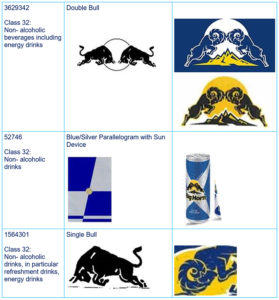Red Bull GmbH v Big Horn UK Limited & Ors [2020] EWHC 124 (Ch)
This case is an interesting commentary on the route that rights holders can pursue in order to challenge lookalike products. Historically, proprietors of well-known brands, particularity in the FMCG market, have found it difficult to succeed in an Article 9(2)(b) claim (of Regulation (EC) No 207/2009 (now Regulation (EU) 2017/1001)), due to the likelihood of confusion element. This is because, although a lookalike product could bear many similarities to the well-known product, shoppers understand that it is a lookalike and not the product itself and so are not confused. Therefore, a claim under this article is often not successful.
This most recent high court case illustrates that rights holders can succeed in a claim by way of Article 9(2)(c) – that the lookalike takes unfair advantage of the reputation of the well-known product – in the pursuit of preventing lookalike products from entering the market and landing on supermarket shelves. To succeed the brand owner has to establish that they own a similar trade mark with a reputation such that the lookalike creates a link in the mind of the consumer with that trade mark, and that this takes unfair advantage of the brand owner’s reputation.
Background
Red Bull (the Claimant) is the proprietor of various highly distinctive trade marks used on energy drinks, bottled water and other non-alcoholic beverages. Red Bull claimed that the signs used by Big Horn on its energy drinks infringed Red Bull’s trade marks.
Red Bull’s marks and the disputed Big Horn signs are as follows:

Red Bull claimed infringement of their trade marks contrary to Article 9(2)(b) and 9(2)(c). In relation to the infringement under Article 9(2)(c), Red Bull did not say that Big Horn’s use of the allegedly infringing signs damaged the distinctive character or reputation of Red Bulls trade marks, but it did say that unfair advantage was taken of the distinctive character or reputation of those trade marks.
The issues
The case concerned the following issues:
- Whether the disputed Big Horn signs are at least similar to the Red Bull trade marks, are used on similar goods and give rise to a likelihood of confusion on the part of the public within the meaning of Article 9(2)(b).
- Whether the disputed signs are at least similar to the Red Bull trade marks, give rise to a link between the sign and the trade mark in the mind of the average consumer, and thereby lead to unfair advantage being taken of the distinctive character or reputation of the Red Bull trade marks, without due cause, within the meaning of Article 9(2)(c).
The court found that the average consumer would perceive the Big Horn products as cheaper or alternative versions of Red Bull’s products, stimulating sales of the former in a way that would not have occurred had the Big Horn signs not evoked so directly the visual and conceptual forms of the Red Bull trade marks. So, even though confusion was not caused, the link in the mind of the consumer helped Big Horn in communicating what the product was and so in essence was “free-riding” on the reputation that Red Bull had invested so heavily in, such that infringement was found within the scope of Article 9(2)(c).
The Red Bull decision is encouraging for rights owners in sectors such as FMCG, who wish to prevent lookalike products from landing on supermarket shelves. It also fits with what the lookalike sellers are trying to do – bring to mind the market leader and communicate to the consumer that this is a cheaper version of that market leading product. However, it is not always easy to establish – the brand owner needs to own suitable registrations (where similarity is often due to overall combinations of elements and not because of the use of a similar name or one distinctive aspect of the packaging), and clear use of the trade mark in question will need to be heavily documented to establish reputation. However, with the right trade mark strategy and good evidence this is a move forward in the battle against lookalikes.
_____________________________
To make sure you do not miss out on regular updates from the Kluwer Trademark Blog, please subscribe here.


